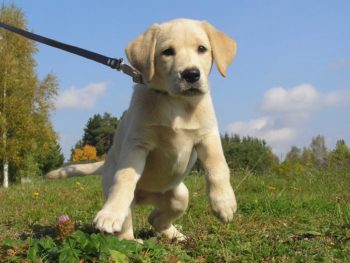Leash Puppy Training
I’ve have been training professionally in Charlotte North Carolina since 1989. Training puppies to walk on a leash for the first time, I do literally every week.
Repetition and Patients
First and foremost realize that each dog takes to the leash at a different pace. Some dogs take to the leash quickly with no fuss. While others feel the leash and start rolling on the ground and screaming murder. Taking your time is the mindset you should set each time you start with the leash training. Remember that a dog fighting the leash is more likely “fear” of the trapped feeling some puppies feel, with the control of the leash.

Puppy leash training
Training Leash and collar:
Start with a flat collar and a 6-foot leash. (Leather, Nylon Webbing or Biothane) Some treats your puppy loves like life abundance treats. An open area outside, with grass and other distractions.
Get in puppy’s head.
Before starting leash training you should consider what the leash means to your dog.
Example #1 – Your dog enjoys a yard with lots of freedom and never spends time in a small room of crated area alone. To this little guy, the leash represents a loss of freedom and control.
Example #2 – Spending time in a crate or small room alone regularly. The yard is not fenced and you must take your dog out only on a leash for leash laws and or his safety. To this pup, the leash represents freedom from the small room and or crate and exploration of the yard.
Prior to starting the leash training:
First, make certain your dog’s collar is fitting very snug. Dogs learn a little head flip that sends the collar over their head very quickly. it needs to be snug enough to not allow three fingers under your dog’s collar with the collar is placed at the top of his neck. Making sure he is not choking with the collar in place.
Second, isolate your dog from family and yourself for at least 30 minutes. Also, select the time for training to be just before and meal, we want him a little hungry.
Third, allow for at least 15 minutes for each training session.
Time to start training your puppy.
First, each time you approach your dog’s confinement area have the leash in your hand. When you start to remove him from his restricted area place the leash on him prior to allowing him to exit that area. occasionally approach his restricted area without the leash ignoring your puppy and not letting him out. it will not take long for your puppy to associate the leash in your hand with his freedom.
Second, Carry your puppy to the open doorway or the edge of the grass outside. Place him on the ground with the leash in your hand. Follow him around the yard while he is exploring. Maintain a leash lose most of the time. Occasionally let him feel the tension on the leash for brief moments at a time. 1 second of slight drag as he is driven to explore a scent. release the drag or pressure offer verbal praise or a treat or both and follow him once again creating a little drag on the leash. After a few trips outside try veering to one side of puppies intended path just slightly. Once in a while when your puppy seems to notice the leash and is not struggling to get free give him a treat.
Third, use members of the family to stand apart in the yard. The leash is then used to guide your young dog to each family member, they, of course, offer physical affection and treats each time he approaches them. Don’t let him pick which person.
If all else fails:
if he panics and freezes use a treat to lure him around the yard with the leash dragging the ground. After a few treats pick up the leash and apply a little bit of pressure to the leash as you hand him a treat.
In conclusion:
Proform steps one and two a few training session before moving on to step three. Your dog thinks the only way he is leaving the restricted area in on the leash. The leash also gets him out of the house into the grass where he loves to Relieve himself and explore. Tention on the leash means follow my guidance and your gonna get attention from the family and treats.
Mark Thompson
Dog Training In Your Home
Charlotte, North Carolina.
704-573-3647